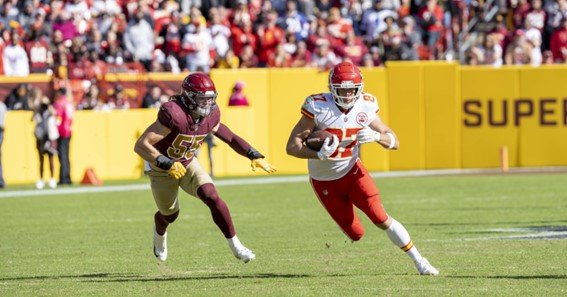In American football, the tight end (TE) is a pivotal offensive position, blending the roles of both offensive linemen and wide receivers. This unique combination requires tight ends to possess a diverse skill set, enabling them to contribute effectively in various facets of the game.
Role and Responsibilities of a Tight End
Tight ends are positioned adjacent to the offensive tackles on the line of scrimmage. Their responsibilities encompass:
- Blocking: Assisting in run blocking by creating pathways for running backs and providing pass protection for quarterbacks.
- Receiving: Running routes to catch passes, utilizing their size and agility to exploit mismatches against defenders.
This dual functionality makes tight ends indispensable in modern offensive schemes, offering flexibility in both ground and aerial attacks.
Physical Attributes
Typically, tight ends are among the taller and heavier players on the team, with an average height of around 6 feet 4 inches and a weight exceeding 250 pounds. This stature enables them to effectively block larger defensive players while also serving as substantial targets in the passing game. Notable examples include Vernon Davis, who combined exceptional speed with considerable size, running a 4.38-second 40-yard dash at 6 feet 3 inches and 248 pounds.
Evolution of the Tight End Position
The tight end position has evolved significantly, with players now expected to excel in multiple roles. Some tight ends specialize in blocking, acting as an additional lineman, while others focus on receiving, leveraging their athleticism to create mismatches in the defensive secondary. This evolution reflects the increasing complexity and versatility demanded in modern football offenses.
Conclusion
The tight end is a multifaceted position in football, requiring a blend of physicality, agility, and intelligence. Their ability to adapt to various roles on the field makes them a critical component of offensive strategies, contributing to both the running and passing games.
FAQ
- What distinguishes a tight end from a wide receiver?
- While both can catch passes, tight ends also have significant blocking duties and typically line up next to the offensive line, whereas wide receivers primarily focus on catching passes and line up farther from the line.
- Can tight ends carry the ball like running backs?
- Although uncommon, certain play designs, such as end-arounds or trick plays, may involve tight ends carrying the ball.
- What jersey numbers do tight ends wear?
- In the NFL, tight ends can wear numbers 0–49 and 80–89, though most traditionally wear numbers in the 80s.
- How has the role of tight ends changed over time?
- Historically, tight ends were primarily blockers. However, modern offenses utilize them as versatile players who can block and serve as key receivers, adapting to various offensive schemes.
- Who are some renowned tight ends in football history?
- Notable tight ends include Tony Gonzalez, Rob Gronkowski, and Travis Kelce, all known for their exceptional receiving skills and significant impact on the game.
Take a look at this interesting piece teac-asio-drivers-whats-new
- Notable tight ends include Tony Gonzalez, Rob Gronkowski, and Travis Kelce, all known for their exceptional receiving skills and significant impact on the game.










